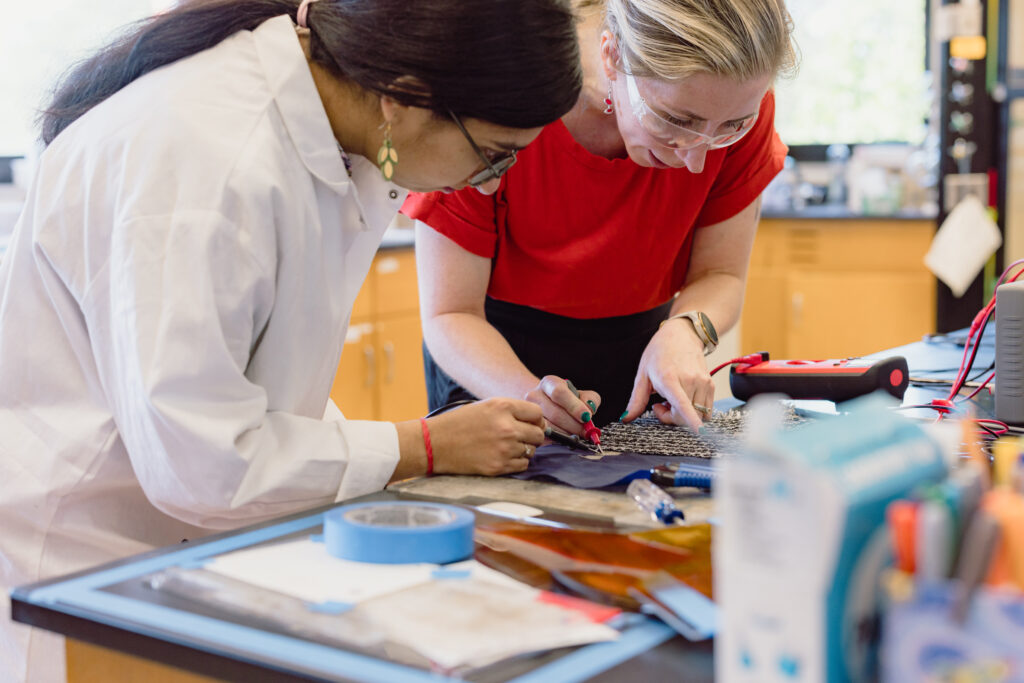
Editor’s note: North Carolina State University (NC State) colleagues, Dr. Kavita Mathur and Dr. Amanda Mills have both contributed to the following responses to my questions about current research in materials science. – Janet Preus, senior editor, Textile Technology Source
Q: I’d like to get a handle on what researchers – including you and your colleagues – are working on right now. What’s the focus of your current research, and what is motivating it?
A: Mathur. My primary research focuses on the design, manufacture, and process–structure–property relationships of textile materials, with a strong emphasis on end-use performance and application. Prior to joining NC State, my research and development work in industry encompassed healthcare textiles, including the impact of textiles on health, sleep, performance and comfort; functional and interactive textile solutions; material innovation; end-use performance; and fiber composites.
My current academic research program bridges design, materials science, and biomedical applications, with a translational “bench-to-bedside” approach. It focuses on generating multidisciplinary, health-centered innovations. One of my specific areas of research focuses on advancing textile fabrication technologies to support next-generation wearable health systems. Specifically, I develop and validate simulation-based tools that enhance the design and functionality of garments for biomedical applications, such as ECG-monitoring sports bras and medical compression wear.
By integrating AI-powered textile digitization, virtual fit modeling and contact pressure prediction, my work addresses the critical relationship between fabric behavior and biosignal performance. Through comparative analyses of physical and virtual drape characteristics and the use of commercial 3D garment simulation platforms, I aim to bridge textile science with digital innovation, enabling more precise, inclusive and performance-driven fabrication of smart garments.
A: Mills. My research focuses on developing and using innovative methods for integrating electronics into textiles and creating smart systems. It is important to use a holistic approach to create electronic textiles, considering not only the material and performance requirements, but also the end user preferences and aesthetics. To that end, my group utilizes a range of fabrication methods, including weaving, knitting, embroidery, screen-printing, and inkjet printing, that enable us to embed soft sensors and electronics both within and onto the textile.
I also use these techniques to investigate innovative connection and interconnection methods across a garment. Soft connections that maintain mechanical and electrical durability are critical to achieving consumer adoption of smart textiles as they enable functionality without compromising inherent textile properties. In doing so, we are able to create smart, textile-based platforms that address multidisciplinary challenges in healthcare, information gathering, rehabilitation and thermal comfort, among other applications.
Q: You both have considerable expertise in wearable technology, especially in healthcare andmedical applications. The challenges, generally, have been powering these devices so they work reliably; washability; and increasingly there’s been attention on comfort. Could you tell us about improvements in wearable textile technology, and what is “in the works” now?
A: Wearable textile technology has evolved rapidly, especially with the integration of advanced digital tools and material innovations. Recent improvements focus on embedding functionality directly into fabrics. [This includes] biosignal sensing, pressure distribution and responsive fit—without compromising comfort or aesthetics. For example, we’re seeing significant strides in smart garments that monitor physiological data like ECG, using soft, fabric-based sensors seamlessly incorporated into sportswear.
One key advancement is the use of simulation-based contact pressure modeling, which allows researchers and designers to predict and optimize how garments interact with the body—especially for medical-grade wear like compression waistbands or ECG-monitoring bras. AI-powered textile digitization and virtual fabric drape modeling are also improving how we prototype and fabricate garments before physical sampling, saving time and resources.
Washability remains a major barrier to the broader adoption of e-textile products, as there are currently no standardized wash testing methods or protocols to reliably assess their durability. This leads to inconsistency, with e-textiles labeled as washable showing significant variation in reliability after repeated laundering.
Existing textile standards do not adequately address the integration of electronic components or the associated safety concerns. To address this, we are developing specialized testing protocols that examine how different washing conditions—such as temperature, agitation and fabric type—affect the performance of conductive inks and printed circuits.
Initial findings from a comprehensive washability study suggest that ink durability is influenced more by the combination of temperature and agitation type than by detergent type. Notably, inks printed on smooth, soft knit fabrics showed lower resistance values compared to those on rougher woven fabrics. This is likely due to the smoother surface enabling more uniform ink application and the greater flexibility of knits reducing cracking caused by fabric creasing—ultimately preserving the functionality of the printed electronics.
What’s “in the works” now in wearable textile technology spans multiple fronts—from immediate design enhancements to long-term infrastructural advancements. Near-term efforts focus on refining digital twin technologies for textiles, enabling personalized fit simulations and advancing inclusive design practices that better account for diverse body types and movement patterns.
At the same time, there is growing momentum behind multifunctional e-textiles that can adapt in real time—adjusting compression levels or biosignal fidelity based on biometric feedback. These innovations are steadily moving us toward intelligent garments that are not only functional, but also reliable, durable and safe for everyday use.
However, for smart textiles to be widely adopted as mainstream products, significant foundational work remains. Key technological gaps exist in three main areas: performance prediction, generative design and optimization, and supply chain integration.
In terms of performance prediction, there is tremendous opportunity to develop soft avatars, fabric hierarchy models and sensor performance simulations that integrate dynamic avatar motion and electrical signal mapping. Circuit modeling and tools borrowed from the electrical engineering domain—such as SPICE simulators—are of particular interest for advancing this space. These innovations are crucial for creating a digital ecosystem that supports accurate CAD/CAE/CAM tools capable of representing the complexity of real-world textile behaviors.
On the design optimization front, future tools must improve both development efficiency and product sustainability. This includes optimizing e-textile patterns for minimal material waste, enhancing fit and biosignal data quality, and automatically routing circuit traces or components based on avatar geometry and required performance characteristics. Generative design tools with performance-driven algorithms will be essential for enabling these efficiencies.
Finally, the development of digital infrastructure to link the e-textile supply chain—commonly referred to as the “digital thread”—is essential for scalable manufacturing. A promising area of research is the creation of machine-readable technical data packages (TDPs), which would allow seamless translation of design intent into production parameters. This requires in-depth understanding of machine settings and their relationship to textile structure and performance.
Additionally, the creation of standardized process design kits (PDKs), similar to those used in flexible hybrid electronics (FHEs), offers a blueprint for how the e-textile industry can build upon advances in parallel sectors to create scalable, interoperable and manufacturable smart textile systems. Together, these research trajectories aim to transform smart textiles from promising prototypes into practical, everyday solutions.
Q: Perhaps improvements now need to be multi-faceted. For example, it would be desirable to create a more efficient means of powering an e-textile if the e-textile is also more eco-friendly. Is this the case?
A: Yes, this is absolutely the case—and the need for multi-faceted improvements in e-textile development is becoming increasingly central to current research and innovation.
While much of the work so far has focused on enhancing functionality, such as optimizing biosignal quality, fit and durability through simulation-based pressure modeling and digital textile design, there is a growing recognition that performance alone is not enough. Researchers and developers are now actively exploring ways to improve the sustainability and energy efficiency of e-textiles in tandem.
For instance, ongoing efforts in pattern optimization aim not only to enhance technical performance but also to reduce material waste, a key step toward more eco-conscious fabrication. Similarly, initiatives around supply chain digitization and machine-readable technical data packages (TDPs) are designed to streamline manufacturing while reducing excess production and resource consumption.
On the powering side, the integration of flexible hybrid electronics (FHEs) opens doors for using low-power, high-efficiency systems in garments. While not yet fully mainstream, there is active exploration of energy-harvesting textiles, biodegradable components, and more efficient circuit design—aligned with broader goals of eco-friendliness, wearability and user safety.
So yes, the future of wearable textile innovation is inherently multi-dimensional, requiring solutions that perform reliably, adapt intelligently and contribute positively to environmental and social sustainability.
Q: Multi-functionality is closely related. How does ongoing research in materials for textiles approach this?
A: Ongoing research in textile materials is increasingly geared toward multi-functionality, recognizing that future e-textiles must serve multiple roles—such as sensing, responding, adapting and enduring—without compromising comfort, safety or sustainability.
One major area of focus is conductive inks and fabrics that can not only collect biosignals, but also maintain flexibility, durability and washability. For instance, studies have shown that fabric structure and surface texture (e.g., knits vs. wovens) can significantly impact the performance of printed conductive inks, affecting both signal quality and mechanical resilience. This highlights the importance of material-fabrication compatibility in achieving reliable, multi-functional performance.
Research is also exploring how textiles can adapt in real time, such as adjusting compression levels or biosignal fidelity based on user movement or biometric feedback—essentially enabling garments to sense and respond dynamically. These smart materials are often developed in conjunction with simulation-based modeling, allowing for optimized placement of sensors, circuit traces and mechanical functions in a single integrated system.
Additionally, future material innovation is being informed by the development of digital design and manufacturing tools, such as soft avatars and CAD/CAE systems, that simulate both structural and electrical behavior. These tools enable more precise integration of multi-functional capabilities into the textile design phase—from comfort and fit, to data acquisition and power efficiency.
Altogether, the materials research landscape is moving toward a systems-level approach, where textiles are no longer just passive substrates but become active, responsive platforms—bridging functionality, user experience, and sustainability in a unified fabric architecture.
Amanda Mills, Ph.D., assistant professor, is co-director TE/TT Capstone Course, Wilson College of Textiles, Textile Engineering, Chemistry, and Science, North Carolina State University
Kavita Mathur, Ph.D., associate professor, is interim director of graduate programs, Dept.of Textiles and Apparel, Technology and Management, Wilson College of Textiles, North Carolina State University.
 TEXTILES.ORG
TEXTILES.ORG


